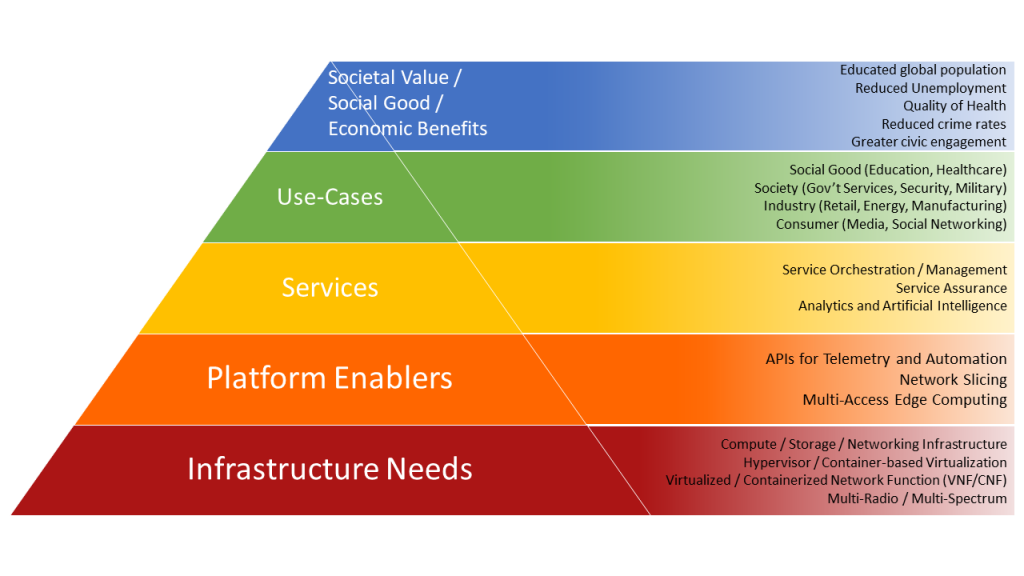From architecture to operations, 5G networks have the potential to drive industries towards digital transformation in ways that we’ve not seen with prior generations of mobile technologies. Whether it be the architectural flexibility to add new capabilities incrementally (prior G’s required end-to-end generational updates), or the industry-centric perspective of 5G use-cases (prior G’s focused on singular consumer experience), I often find that my team and I focus extensively on Four Pillars of 5G Transformation:
- Network Modernization, towards a virtualized and software-defined network
- IT and OSS/BSS Transformation towards data-driven decisions
- Digital Transformation, delivering joint enterprise solutions in partnership with SP
- Workforce Transformation, focused on defining the skill sets and new operating models for realizing cost efficiencies and new revenue models
As the Dell Technologies representative in the World Economic Forum, Global Future Council on New Network Technologies, I am also exposed to the implications of 5G far-reaching beyond the technology and business opportunities being developed on 5G. The societal value and social good that can be achieved by applying cloud operating economics to mobile networking is one that I am seeing first-hand and, seeing these use-cases, provides a new sense of purpose in our 5G work. This purpose is bigger than any technology, or architecture, or path to revenue, and it led me to reflect on Maslow’s Hierarchy of Needs, and how the work Dell Technologies performs applies directly to helping achieve that end-goal of benefitting society. I modeled this as follows:
 Infrastructure Needs: While it might be a bit self-serving for Dell Technologies that the 5G platform necessary to achieve the top hierarchy is built on a foundation of technologies that align directly to our portfolio, there is no denying that the foundational layer of Infrastructure Needs is driven by the ability to modernize network infrastructure, with virtualized and containerized functions residing on a software-programmable architecture integrated with multiple radio technologies in both licensed and unlicensed spectrum bands.
Infrastructure Needs: While it might be a bit self-serving for Dell Technologies that the 5G platform necessary to achieve the top hierarchy is built on a foundation of technologies that align directly to our portfolio, there is no denying that the foundational layer of Infrastructure Needs is driven by the ability to modernize network infrastructure, with virtualized and containerized functions residing on a software-programmable architecture integrated with multiple radio technologies in both licensed and unlicensed spectrum bands.
- Platform Enablers: Realizing the infrastructure components as a platform enables a new set of capabilities to be exposed to services, driven by APIs that enable new service functions. Technologies such as network slicing and multi-access edge computing are paramount to creating lower-latency, more immersive, and data-driven service offerings.
- Services: In the context of 5G, the services layer is the unifying framework upon with new use-cases that can be built. These services – orchestration, assurance, analytics, and AI – provide the “glue” between the capabilities of the underlying individual platform functions/capabilities and the requirements of the use-cases. In other words, services make the platform enablers and infrastructure consumable.
- Use–Cases: We tend to focus on the capabilities of 5G to deliver new services to both consumers and industries, such as retail, energy and manufacturing. The ability of 5G to impact society, ranging from government services to military operations, and to deliver step-function improvements in education and healthcare by integrating new technology, expanding the reach of knowledge and personalizing experiences is sometimes overlooked as we focus on nearer-term, direct correlations to driving economics.
- Societal Value / Social Good / Economic Benefits: Let’s not overlook, however, the benefits that a healthy, well-educated, connected society can provide. There are several studies performed over long-time horizons that highlight the benefits of education and healthcare to driving down unemployment, increasing global GDP, lowering crime rates, and improving civic engagement. By connecting today’s unconnected population with a range of new network technologies, including 5G, we are all set to benefit.
As Maslow has often described, the lower four layers of the Hierarchy of Needs are driven by deprivation – or having “needs” that are unmet. As I look at 5G positioning in the industry, from use-cases offered by service providers to infrastructure provided by vendors, we are motivated by satisfying the need to build a common platform, operate that platform in new ways, and utilize that platform to drive new service offerings across multiple industries.
Over time, however, the industry will realize these benefits and the “need” will have been met – while the benefits to society and the global economy will persist well after 5G networks have been architected, deployed, and scaled for global operations. Just looking briefly at some use-cases that we can expect to see:
- 5G and Education: AR/VR-based immersive experiences, personalized teaching methods tailored to learning styles, special needs assistance, etc.
- 5G and Government Services: Improved first-response, road safety, improved security (esp. cybersecurity), transmission of safety information, improved civil services.
- 5G and Healthcare: Improved remote patient monitoring, TeleHealth / TeleMedicine, movement of vital health information (such as medical imagery), robotic surgery.
It’s beneficial to put the daily grind of activities that we do for work into the context of a higher purpose – we are making an impact. Dell Technologies believes in #technologyforgood. We have already made advancements in many of these areas as we continue to keep health, education, environment and social good top of mind as we build the most powerful network the world has ever seen.